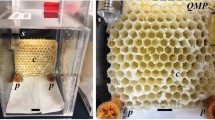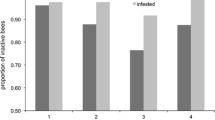Abstract
Invasion behaviour of Varroa jacobsoni into honey bee brood cells was studied using an observation hive. The mites were carried close to a suitable brood cell by the bees. Subsequently, the mites moved from the bees to the rim of the cell, walked quickly inside, crawled between the larva and the cell wall, and moved onto the bottom of the cell. Varroa mites were never seen walking across the comb, and entering and leaving brood cells as has been described for Tropilaelaps clareae. Differences in invasion strategies between V. jacobsoni and T. clareae are discussed.
Similar content being viewed by others
References
Beetsma, J., Boot, W. J. and Calis, J.N.M., 1993. Special techniques to make detailed observations of Varroa mites staying on bees and invading honeybce brood cells. In: L.J. Connor, T. Rinderer, H.A. Sylvester and S. Wongsiri (Editors), Asian apiculture. Wicwas Press, Cheshire CT, USA, pp. 510–520.
Boot, W.J., Calis, J.N.M. and Beetsma, J., 1992. Differential periods of Varroa mite invasion into worker and drone cells of honey bees. Exp. Appl. Acarol., 16: 295–301.
Boot, W.J., Calis, J.N.M. and Beetsma, J., 1993. Invasion of Varroa jacobsoni into honey bee brood cells: a matter of chance or choice? J. Apic. Res., 32: 167–174.
Boot, W. J., Sisselaar, D.J.A., Calis, J.N.M. and Beetsma, J., 1994. Factors affecting invasion of Varroa jacobsoni (Acari: Varroidae) into honeybee, Apis mellifera (Hymenoptera, Apidae), brood cells. Bull. Entomol. Res., 84: 3–10.
Brouwers, E.V.M., Ebert, R. and Beetsma, J., 1987. Behavioural and physiological aspects of nurse bees in relation to the composition of larval food during caste differentiation in the honeybee. J. Apic. Res., 26: 11–23.
Büchler, R., 1989. Attractivity and reproductive suitability for the Varroa-mite of beebrood from different origin. In: R. Cavalloro (Editor), Present status of Varroatosis in Europe and progress in the Varroa mite control. Commission of the European Communities, Luxembourg, pp. 139–145.
Büchler, R., Drescher, W. and Tornier, I., 1992. Grooming behaviour of Apis cerana, Apis mellifera and Apis dorsata and its effect on the parasitic mite Varroa jacobsoni and Tropilaelaps clareae. Exp. Appl. Acarol., 16: 313–319.
De Jong, D., Morse, R.A. and Eickwort, G.C., 1982. Mite pests of honey bees. Annu. Rev. Entomol., 27: 229–252.
Fuchs, S., 1985. Untersuchungen zur Quantitativen Abschätzung des Befalls von Bienenvölkern mit Varroa jacobsoni Oudemans und zur Verteilung des Parasiten im Bienenvolk. Apidologie, 16: 343–368.
Fuchs, S., 1990. Preference for drone brood cells by Varroa jacobsoni Oud. in colonies of Apis mellifera carnica. Apidologie, 21: 193–199.
Goetz, B. and Koeniger, N., 1993. The distance between larva and cell opening triggers broodcell invasion by Varroa jacobsoni. Apidologie, 24: 67–72.
Ifantidis, M.D., 1988. Some aspects of the process of Varroa jacobsoni mite entrance into honey bee (Apis mellifera) brood cells. Apidologie, 19: 387–396.
Ifantidis, M.D. and Rosenkranz, P., 1988. Reproduktion der Bienenmilbe Varroa jacobsoni (Acarina: Varroidae). Entomol. Gen., 14: 111–122.
Kraus, B., 1993. Preferences of Varroa jacobsoni for honey bees (Apis mellifera L.) of different ages. J. Apic. Res., 32: 57–64.
Kraus, B., Koeniger, N. and Fuchs, S., 1986. Unterscheidung zwischen Bienen verschiedenen Alters durch Varroa jacbsoni Oud. und Bevorzugung von Ammenbienen im Sommerbienenvolk. Apidologie, 17: 257–266.
Laigo, F.M. and Morse, R.A., 1968. The mite Tropilaelaps clareae in Apis dorsata colonies in the Philippines. Bee World, 49: 116–118.
Le Conte, Y., Arnold, G., Trouiller, J., Masson, C., Chappe, B. and Ourisson, G., 1989. Attraction of the parasitic mite Varroa to the drone larvae of honey bees by simple aliphatic esters. Science, 245: 638–639.
Otten, C. and Fuchs, S., 1988. Individual differences in Varroa jacobsoni of preference for drone larvae to worker bee larvae. In: R. Cavalloro (Editor), European research on varroatosis control. A.A. Balkema, Rotterdam, The Netherlands, pp. 69–71.
Peng, Y.-S., Fang, Y., Xu, S. and Ge, L., 1987. The resistance mechanism of the Asian honey bee, Apis cerana Fabr., to an ectoparasitic mite, Varroa jacobsoni Oudemans. J. Invertebr. Pathol., 49: 54–60.
Rath, W., 1993. Aspects of preadaptation in V. jacobsoni while shifting from its original host A. cerana to A. mellifera. In: L.J. Connor, T. Rinderer, H.A. Sylvester and S. Wongsiri (Editors), Asian apiculture. Wicwas Press, Cheshire CT, USA, pp. 417–426.
Rickli, M., Guerin, P.M. and Diehl, P.A., 1992. Palmitic acid released from honeybee worker larvae attracts the parasitic mite Varroa jacobsoni on a servosphere. Naturwissenschaften, 79: 320–322.
Ritter, W., 1981. Varroa disease of the honeybee Apis mellifera. Bee World, 62: 141–153.
Rosenkranz, P. and Engels, W., 1985. Konsequente Drohnenbrutentnahme, eine wirksame biotechnische Massnahme zur Minderung von Varroatose-Schäden an Bicnenvölkern. Allg. Dtsch. Imkerztg, 19: 265–271.
Ruijter, A.de and Calis, J.N.M., 1988. Distribution of Varroa jacobsoni female mites in honey bee worker brood cells of normal and manipulated depth (Acarina: Varroidae). Entomol. Gen., 14: 107–109.
Schulz, A., Koeniger, N. and Ruttner, F., 1983. Drohnenbrut als Varroafalle. Allg. Dtsch. Imkerztg, 17: 52–54.
Woyke, J., 1984. Survival and prophylactic control of Tropilaelaps clareae infesting Apis mellifera colonies in Afghanistan. Apidologie, 15: 431–434.
Woyke, J., 1987. Comparative population dynamics of Tropilaelaps clareae and Varroa jacobsoni mites on honeybees. J. Apic. Res., 26: 196–202.
Woyke, J., 1989. Change in shape of Tropilaelaps clareae females and the onset of egg laying. J. Apic. Res., 28: 196–200.
Author information
Authors and Affiliations
Rights and permissions
About this article
Cite this article
Boot, W.J., Beetsma, J. & Calis, J.N.M. Behaviour of Varroa mites invading honey bee brood cells. Exp Appl Acarol 18, 371–379 (1994). https://doi.org/10.1007/BF00116318
Accepted:
Issue Date:
DOI: https://doi.org/10.1007/BF00116318




